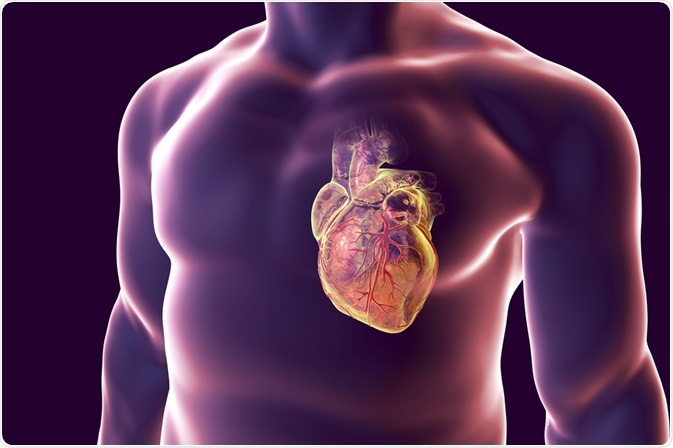Myocarditis is the term used to describe the acute infective, autoimmune, or toxic inflammation of the heart muscle, which is also known as myocardium. Most cases of myocarditis with onset in otherwise healthy individuals usually arise as a result of infection by common viruses, although precise pathogenesis is not always easily determined. Symptoms can range from mild dyspnea and chest pain to cardiogenic shock and death.

Image Credit: Kateryna Kon / Shutterstock.com
The prognosis and treatment of myocarditis depend on the etiology, while clinical and hemodynamic data can provide guidance to decide when the patient needs to be referred to a specialist for endomyocardial biopsy. Important prognostic variables include the presence of a heart block, degree of left and right ventricular dysfunction, and specific histopathological forms of myocarditis.
Causes
Even though a broad spectrum of etiologies has been implicated as causes of myocarditis, viral myocarditis still represents the prototype for studying this disease and its evolution. Enteroviruses (namely Coxsackie group B serotypes) have traditionally been perceived as the predominant viral cause of myocarditis; however, the development of new molecular techniques resulted in the recognition of parvovirus B19 and human herpesvirus 6 as the main viral causes of myocarditis.
Hepatitis C virus has also been associated with myocarditis, as HCV antibodies and RNA have been found in the sera and cardiac tissue of patients with biopsy-proven myocarditis. Furthermore, in patients with human immunodeficiency virus (HIV), infectious myocarditis is considered the strongest predictor of death among a large cardiomyopathy population and is observed in more than 50% of performed autopsies.
Myocarditis can also be triggered by different non-viral infections, which should certainly be considered in patients with acute or chronic cardiomyopathy. The condition can often arise from the infection with Borrelia burgdorferi, which is a cause of Lyme disease. It must also be noted that patients with myocarditis due to Lyme disease are sporadically co-infected with babesia or Ehrlichia. In areas of rural Central and South America, Trypanosoma cruzi infections can manifest as acute myocarditis.
Drug-induced hypersensitivity and systemic hypereosinophilic syndromes may result in specific myocarditis. Some of the different drugs that are implicated in this condition include antibiotics, namely penicillins, cephalosporins, and sulfonamides, anticonvulsants, antipsychotics, and antidepressants. Smallpox vaccination has also recently been recognized as a causative factor of myopericarditis.
Cardiac sarcoidosis and giant cell myocarditis, which are two idiopathic and histologically similar disorders, represent rare causes of inflammatory myocardial disease. Autoimmune diseases that are associated with myocarditis include Whipple’s disease, celiac disease, systemic lupus erythematosus, mixed connective tissue disease, systemic sclerosis, and certain hematological abnormalities such as thrombocytopenic purpura.
Myocarditis, Causes, Signs and Symptoms, Diagnosis, Treatment
Clinical manifestations
Three essential pathways have been implicated in the pathogenesis of myocarditis. Direct myocardial invasion by cardiotropic viruses or other causes of the disease swiftly progresses to the second phase of immunologic activation. The activation of CD4+ T helper cells induces clonal expansion of B cells, resulting in additional myocytolysis, further local inflammation, as well as the production of circulating anti-heart antibodies.
Acute myocarditis is often initially diagnosed as nonischemic dilated cardiomyopathy in a patient with symptoms present for a few weeks to several months. However, clinical manifestations range from asymptomatic echocardiogram (ECG) abnormalities to devastating illness with cardiogenic shock, with the possible occurrence of atrial or ventricular arrhythmias, heart block, or an acute myocardial infarction–like syndrome.
Transient ECG abnormalities are commonly observed during community viral epidemics, with most patients remaining entirely asymptomatic. Affected individuals sometimes report a typical viral prodrome that consists of fever, respiratory symptoms, myalgias (muscle pain), and occasional gastroenteritis; however, these symptoms are highly variable. On the other hand, myocarditis can manifest as fulminant heart failure with an abrupt onset of the hemodynamic collapse.
The true incidence of myocarditis in the community remains unknown, as the disease is a complex and challenging diagnosis in cardiology. No large population-based studies defining the presenting symptoms of acute myocarditis are currently available, in part due to the lack of sensitive and non-invasive diagnostic tests. As the relationship between clinical findings and the presence of acute myocarditis remains vague, a very sensitive and specific diagnostic procedure is warranted.
References
Further Reading
Last Updated: Mar 22, 2021